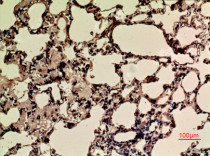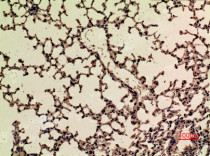ARG66899
anti-Nrf 2 acetyl (Lys599) antibody
anti-Nrf 2 acetyl (Lys599) antibody for IHC-Formalin-fixed paraffin-embedded sections,Western blot and Human,Mouse,Rat
Overview
| Product Description | Rabbit Polyclonal antibody recognizes Nrf 2 acetyl (Lys599) |
|---|---|
| Tested Reactivity | Hu, Ms, Rat |
| Tested Application | IHC-P, WB |
| Host | Rabbit |
| Clonality | Polyclonal |
| Isotype | IgG |
| Target Name | Nrf 2 |
| Antigen Species | Human |
| Immunogen | Synthetic acetyl-peptide around Lys599 of Human Nrf 2. |
| Conjugation | Un-conjugated |
| Alternate Names | Nuclear factor, erythroid derived 2, like 2; NF-E2-related factor 2; Nuclear factor erythroid 2-related factor 2; HEBP1; NRF2; NFE2-related factor 2 |
Application Instructions
| Application Suggestion |
|
||||||
|---|---|---|---|---|---|---|---|
| Application Note | * The dilutions indicate recommended starting dilutions and the optimal dilutions or concentrations should be determined by the scientist. | ||||||
| Positive Control | A549 | ||||||
| Observed Size | ~ 68 kDa |
Properties
| Form | Liquid |
|---|---|
| Purification | Affinity purification with immunogen. |
| Buffer | PBS, 0.02% Sodium azide, 50% Glycerol and 0.5% BSA. |
| Preservative | 0.02% Sodium azide |
| Stabilizer | 50% Glycerol and 0.5% BSA |
| Concentration | 1 mg/ml |
| Storage Instruction | For continuous use, store undiluted antibody at 2-8°C for up to a week. For long-term storage, aliquot and store at -20°C. Storage in frost free freezers is not recommended. Avoid repeated freeze/thaw cycles. Suggest spin the vial prior to opening. The antibody solution should be gently mixed before use. |
| Note | For laboratory research only, not for drug, diagnostic or other use. |
Bioinformation
| Database Links | |
|---|---|
| Gene Symbol | NFE2L2 |
| Gene Full Name | nuclear factor, erythroid 2-like 2 |
| Background | This gene encodes a transcription factor which is a member of a small family of basic leucine zipper (bZIP) proteins. The encoded transcription factor regulates genes which contain antioxidant response elements (ARE) in their promoters; many of these genes encode proteins involved in response to injury and inflammation which includes the production of free radicals. Multiple transcript variants encoding different isoforms have been characterized for this gene. [provided by RefSeq, Sep 2015] |
| Function | Transcription factor that plays a key role in the response to oxidative stress: binds to antioxidant response (ARE) elements present in the promoter region of many cytoprotective genes, such as phase 2 detoxifying enzymes, and promotes their expression, thereby neutralizing reactive electrophiles (PubMed:11035812, PubMed:19489739, PubMed:29018201, PubMed:31398338). In normal conditions, ubiquitinated and degraded in the cytoplasm by the BCR(KEAP1) complex (PubMed:11035812, PubMed:15601839, PubMed:29018201). In response to oxidative stress, electrophile metabolites inhibit activity of the BCR(KEAP1) complex, promoting nuclear accumulation of NFE2L2/NRF2, heterodimerization with one of the small Maf proteins and binding to ARE elements of cytoprotective target genes (PubMed:19489739, PubMed:29590092). The NFE2L2/NRF2 pathway is also activated in response to selective autophagy: autophagy promotes interaction between KEAP1 and SQSTM1/p62 and subsequent inactivation of the BCR(KEAP1) complex, leading to NFE2L2/NRF2 nuclear accumulation and expression of cytoprotective genes (PubMed:20452972). May also be involved in the transcriptional activation of genes of the beta-globin cluster by mediating enhancer activity of hypersensitive site 2 of the beta-globin locus control region (PubMed:7937919). [UniProt] |
| Cellular Localization | Cytoplasm, cytosol. Nucleus. Note=Cytosolic under unstressed conditions, translocates into the nucleus upon induction by electrophilic agents. [UniProt] |
| Calculated MW | 68 kDa |
| PTM | Phosphorylation of Ser-40 by PKC in response to oxidative stress dissociates NFE2L2 from its cytoplasmic inhibitor KEAP1, promoting its translocation into the nucleus. Acetylation at Lys-596 and Lys-599 increases nuclear localization whereas deacetylation by SIRT1 enhances cytoplasmic presence. Ubiquitinated by the KEAP1-CUL3-RBX1 E3 ubiquitin ligase complex and subject to proteasomal degradation. Ubiquitination is inhibited by sulforaphane. [UniProt] |
Images (3) Click the Picture to Zoom In
-
ARG66899 anti-Nrf 2 acetyl (Lys599) antibody IHC-P image
Immunohistochemistry: Paraffin-embedded Rat lung tissue stained with ARG66899 anti-Nrf 2 acetyl (Lys599) antibody at 1:100 dilution.
-
ARG66899 anti-Nrf 2 acetyl (Lys599) antibody WB image
Western blot: A549 cell lysate stained with ARG66899 anti-Nrf 2 acetyl (Lys599) antibody at 1:1000 dilution.
-
ARG66899 anti-Nrf 2 acetyl (Lys599) antibody IHC-P image
Immunohistochemistry: Paraffin-embedded Mouse lung tissue stained with ARG66899 anti-Nrf 2 acetyl (Lys599) antibody at 1:100 dilution.








